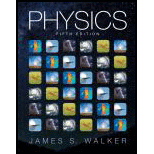
Concept explainers
The brief description of the Ultraviolet Catastrophe.
Answer to Problem 1CQ
Explanation of Solution
Ultraviolet Catastrophe is a classical prediction and is also known as Rayleigh–Jeans catastrophe.
Here the term Ultraviolet refers to the fact that the problem appears in short wavelength region of
Ultraviolet Catastrophe predicts that an ideal black body at thermal equilibrium will emit radiation in all frequency ranges and it emits more energy when the value of frequency increases with infinite power.
The expression for the energy is,
Here,
The above equation can explain the energy distribution curves for longer wavelengths satisfactorily, but fails to explain the curves for smaller wavelengths.
Integrate the above equation from zero to infinity.
Conclusion:
Therefore, Ultraviolet Catastrophe is an event causing great and usually sudden damage or suffering when an ideal black body at thermal equilibrium emits radiation with infinite power.
Want to see more full solutions like this?
Chapter 30 Solutions
Physics (5th Edition)
- Give proof that the violation of the Kelvin–Planck statement leads to the violation of the Clausius statement.arrow_forwardThe cosmic background radiation is blackbody radiation from a source at a temperature of 2.73 K. (a) Use Wien’s law to determine the wavelength at which this radiation has its maximum intensity. (b) In what part of theelectromagnetic spectrum is the peak of the distribution?arrow_forwardWhat is the wavelength of maximum intensity (in nm) and the total energy emitted (in J/s/m2) by a celestial object at 7 K above absolute zero? wavelength of maximum intensity? 414285.71 Total Energy? -----arrow_forward
- Calculate the temperature of a blackbody if the spectral distribution peaks at (a) gamma rays, λ = 1.50 x 10-14 m; (b) x rays, 1.50 nm; (c) red light, 640 nm; (d) broadcast television waves, λ = 1.00 m; and (e) AM radio waves, λ = 204m.arrow_forwardJust wish to ask how to get E=-3KT/2 from fluence rate spectrum ? please provide details thank you very mucharrow_forwardWhy doesn't a photon in a higher wavelength range technically harmful to the body?arrow_forward
- UV light causes sunburn, whereas visible light does not.Suggest a reasonarrow_forwardThe blackbody radiation emitted from a furnace peaks at the wavelenght of 1.2 x 10^-6 m (0.0000012 m). What is the temperature inside the furnace?arrow_forwardFor a blackbody object of given volume, which shape will it emit the leastradiation? Why?arrow_forward
- A furnace emits radiation at 2000 K. Treating it as black body radiation, calculate the wavelength at which the emission is maximum. a.) 1.449 x 10 ^ -6 m b.) 2.449 x 10 ^ -6 m c.) 3.449 x 10 ^ -6 m d.) 4.449 x10 ^ -6 marrow_forwardSuppose that the microwave radiation has a wavelength of 11.6 cm. How many photons are required to heat 265 mL of coffee from 25.0 degrees Celcius to 62.0 degrees Celcius? Assume that the coffee has the same density, 0.997 g/mL, and specific heat capacity, 4.184 J/(g.K), as water over this temperature range.arrow_forwardDescribe the Uncertainty Principle?arrow_forward
 Modern PhysicsPhysicsISBN:9781111794378Author:Raymond A. Serway, Clement J. Moses, Curt A. MoyerPublisher:Cengage Learning
Modern PhysicsPhysicsISBN:9781111794378Author:Raymond A. Serway, Clement J. Moses, Curt A. MoyerPublisher:Cengage Learning Principles of Physics: A Calculus-Based TextPhysicsISBN:9781133104261Author:Raymond A. Serway, John W. JewettPublisher:Cengage Learning
Principles of Physics: A Calculus-Based TextPhysicsISBN:9781133104261Author:Raymond A. Serway, John W. JewettPublisher:Cengage Learning Physics for Scientists and Engineers with Modern ...PhysicsISBN:9781337553292Author:Raymond A. Serway, John W. JewettPublisher:Cengage Learning
Physics for Scientists and Engineers with Modern ...PhysicsISBN:9781337553292Author:Raymond A. Serway, John W. JewettPublisher:Cengage Learning An Introduction to Physical SciencePhysicsISBN:9781305079137Author:James Shipman, Jerry D. Wilson, Charles A. Higgins, Omar TorresPublisher:Cengage Learning
An Introduction to Physical SciencePhysicsISBN:9781305079137Author:James Shipman, Jerry D. Wilson, Charles A. Higgins, Omar TorresPublisher:Cengage Learning



